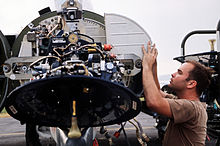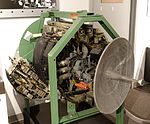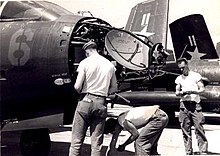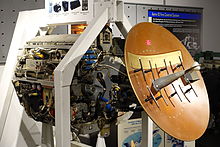94:
351:
38:
131:
253:
702:
85:. AN/APQ-120 has a long line of lineage, with its origin traced all the way back to Aero-13 FCR developed by the same company in the early 1950s. A total of half a dozen FCRs were tested and evaluated on the first 18 F-4s built, but they were soon replaced by later radars produced in great numbers, including AN/APQ-120.
370:
visual mode. AN/AWG-10B was further digitized version of AN/AWG-10/10A but retained many analog circuits. A key AVC (avionics change) was the replacement of the unreliable
Doppler Spectrum Analyzer (DSA) with a reliable Digital Spectrum Processor (DSP) which also increased accuracy when operating in doppler mode.
163:
The AN/APQ-41 was an improvement over the AN/APQ-36, and was designed to provide air intercept, search, to automatically track a selected target, and to supply lead angle and range information. Facilities were also provided for air-to-surface search, for beacon interrogation and response display, and
303:
Modified AN/APQ-100 for the
British to replace the AN/APG-59. As with AN/APG-59, AN/APG-60 also had a radar dish which could be swung sideways in order to reduce the length of the aircraft to 54 feet so that it could fit on the small deck lifts of British carriers. AN/APG-60 was later upgraded with
285:
AN/APG-59 FCR is a modified AN/APQ-72 designed for the
British. The main difference between AN/APG-59 and its predecessor is that the radar dish could be swung sideways in order to reduce the length of the aircraft to 54 feet so that it could fit on the small deck lifts of British carriers. Used in
276:
AN/APQ-72 FCR is a development of AN/APQ-50, with the diameter of the antenna increased by a third to 32 inches from the original 24 inches of AN/APQ-50. AN/APA-128 CW illuminator is integrated with the radar to give it a capability for radar guided AAMs. AN/APQ-72 is the first radar installed on
267:
batch of F-4s, but as with earlier radars, it was not used in great numbers in comparison to later radars of the same family. The parabolic antenna is 24 inches in diameter, and in addition to providing all weather capability, AN/APQ-50 FCR also provides information on automatic firing of rockets.
294:
AN/APQ-100 is the replacement for the AN/APQ-72, and it featured a redesigned radar scope in the rear cockpit that offered a plan position indicator (PPI) mapping display option, and adjustable range strobe for bombing. For air-to-ground missions, the radar interfaced with the inertial platform on
369:
power amplifier. Adding a digital computer allowed much more effective missile launch equations. AN/AWG-10A also incorporated a new servoed optical sight. There were also additions of new modes such as continuously displayed impact point mode, freeze displayed impact mode, and computer released
360:
AN/AWG stands for (A) Piloted
Aircraft (W) Armament (G) Fire Control. AN/APG-59 was the first FCR integrated into AN/AWG-10, which developed into two more versions, A and B. The original AN/AWG-10 can detect an aerial target with 5 square meters radar cross section more than 100 kilometers away.
105:
is the origin of AN/APQ-120, and it established the configuration of the airborne FCR not only for the radar families of AN/APQ-120, but also a standard for all other airborne radars to follow: Aero 13 FCR was designed as an integrated cylindrical module that could be plugged into the nose of an
138:
The next radar to be installed on F-4 prototypes and pre-production series was AN/APQ-35, which was actually consisted of two radars: the AN/APS-21 search radar that could locate fighter-size targets at a range of 32 kilometers (20 miles), and the AN/APS-26 targeting radar, with a range of 3.2
324:
Modified AN/APQ-109 for the
British to replace AN/APG-60. As with AN/APG-59/60, AN/APG-61 also had a radar dish which could be swung sideways in order to reduce the length of the aircraft to 54 feet so that it could fit on the small deck lifts of British carriers. Used in the AN/AWG-12.
316:. Other significant additions included air-to-ground ranging, ground beacon identification and display capabilities. AN/APQ-109 was an improved, more reliable "hybrid" version of the AN/APQ-100 with solid-state components in the low-voltage sections.
411:
AN/AWG-14 is the final member of the lineage of this radar family, and it is a fully digitized upgrade of the AWG series incorporating AN/APQ-120. The open architecture and modular design enable AWG-14 to accommodate different radars, such as
93:
341:
A fully solid-state radar developed from AN/APQ-117, the AN/APQ-120 radar was much more compact than its predecessors, allowing it to fit into the nose along with the cannon, and the radar was later integrated into AN/AWG-14.
398:
AN/AWG-12 was an improved AN/AWG-11 built by
Ferranti with AN/APG-61 FCR. The main difference between AN/AWG-11 and AN/AWG-12 is that the latter has a better ground mapping mode, and it also can control a belly mounted
122:(AAM)s. 1A FCR was developed to add this capability by incorporating a continuous wave illuminator for SARH AAMs. This configuration of Aero 1A remained unchanged for later radars for F-4s all the way until AN/APQ-50.
155:, it was the largest airborne FCR of its time. The more powerful AN/APQ-36 with large size did not have any problem being installed on F-4 prototypes, so that more powerful FCR of larger size would be developed.
364:
AN/AWG-10A is a development of the original AN/AWG-10, with great improvement in reliability and maintainability by replacing the original transmitter in AN/AWG-10 with a solid state unit whose only tube was a
350:
240:
AN/APQ-46 is the last radar tested and evaluated on F-4 prototypes and pre-production series. F-4 equipped with this radar was specifically modified to meet US Navy Ferret
738:
599:
526:
446:
403:. AN/AWG-12 finally retired in 1992 when the last F-4s in British service retired, and during its service life, it was upgraded with improvements of the AN/AWG-10A/B.
733:
451:
37:
312:
AN/APQ-109 is an improvement of the earlier AN/APQ-100 with an improved cockpit display able to handle TV imagery from weapons such as
583:
553:
510:
492:
82:
603:
530:
333:
AN/APQ-117 terrain following and attack radar, developed from earlier AN/APQ-109, with terrain following capability added.
165:
78:
264:
241:
713:
728:
115:
382:. The radar used was AN/APG-60, and AN/AWG-11 is a slightly modified AN/AWG-10 in that it is compatible with
413:
706:
211:
C-scope (Search)-Target strobe, targets, straddled by range strobe, artificial horizon line, scan pattern
148:
687:
130:
659:
257:
152:
119:
102:
74:
61:
208:
B-scope (Search)-Target azimuth and range, range strobe, range markers, beacon and IFF responses
579:
488:
573:
147:
AN/APQ-36 is the improvement over earlier AN/APQ-35, and when AN/APQ-36 entered service on
557:
550:
514:
507:
400:
441:
383:
313:
252:
722:
51:
648:
425:
482:
674:
214:
C-scope (Track)-Target dot, range rate circle and dot, artificial horizon line
429:
421:
417:
701:
379:
366:
304:
Doppler capability during its upgrades, and integrated in the AN/AWG-11.
17:
390:, so that British F-4s can perform nuclear strike missions if required.
277:
F-4s to be built in great numbers, starting with the 19th F-4 produced.
629:
387:
349:
251:
193:
Elevation (Search): 13 deg (within 30 deg of aircraft center line)
129:
225:
Beacon
Frequency: Transmitting, 9375 30 mc; receiving, 9310 1 mc
184:
Tracking
Accuracy: 25 yd within the ranges of 200 and 2,000 yd
575:
USN F-4 Phantom II vs VPAF MiG-17/19: Vietnam 1965-73 (Duel)
244:
aircraft requirement, which eventually did not materialize.
106:
aircraft, instead of a set of semi-independent black boxes.
219:
Fixed Range Marker: 25-mi markers on 100 and 200-mi scales
134:
Maintenance on an APQ-35 radar of a F3D-2 in Korea, 1953
378:AN/AWG-11 was a British AN/AWG-10 license-built by
172:
Search or Gun-Aim Range: 24 nm max, 200 yd min
57:
47:
164:for response display when used in connection with
624:
622:
620:
447:List of military electronics of the United States
578:(1st ed.). Osprey Publishing. p. 15.
487:(1st ed.). Random House Value Publishing.
202:Accuracy (Search and Track): 4% all indications
222:Radar Frequency (Search and Track): 9375 30 mc
8:
669:
667:
476:
474:
472:
470:
468:
466:
30:
567:
565:
36:
29:
739:Military electronics of the United States
452:Joint Electronics Type Designation System
181:Reliable Gun-Aim Prediction: 2,000 yd max
42:F-4E Phantom II with AN/APQ-120 installed
114:Aero 13 did not have any capability for
92:
462:
228:Operating Temperature:-55 to +55 deg C
7:
734:Military radars of the United States
263:AN/APQ-50 is the radar installed on
484:The Great Book of Modern Warplanes
25:
175:Ground Mapping Range: 100 nm
83:McDonnell Douglas F-4E Phantom II
700:
231:Altitude Limit: 52,000 ft
1:
481:Bill Gunston (Dec 12, 1988).
101:The Aero 13 FCR designed for
572:Peter Davis (Nov 17, 2009).
199:Elevation (Track): 116.5 deg
187:Future Range Accuracy: 25 yd
166:identification friend or foe
714:RadarTutorial.eu AN/APQ-120
556:September 21, 2012, at the
513:September 26, 2012, at the
265:low-rate initial production
190:Azimuth (Search): 106.5 deg
97:Aero-13 Fire Control System
27:Aircraft fire control radar
755:
196:Azimuth (Track): 116.5 deg
242:electronic countermeasure
178:Beacon Range: 200 nm
35:
354:AN/AWG-10 with AN/APG-59
116:semi-active radar homing
168:(IFF). Specifications:
355:
260:
205:Type of Presentation:
139:kilometers (2 miles).
135:
98:
77:(FCR) manufactured by
48:Country of origin
709:at Wikimedia Commons
353:
255:
149:Douglas F3D Skyknight
133:
96:
630:"AN/APQ-100/109/120"
428:EL/M-2011/2021 and
32:
356:
261:
258:Douglas F4D Skyray
256:APQ-50 radar of a
153:Vought F7U Cutlass
136:
120:air-to-air missile
103:Douglas F4D Skyray
99:
75:fire control radar
62:Fire-control radar
705:Media related to
67:
66:
16:(Redirected from
746:
704:
690:
685:
679:
678:
671:
662:
657:
651:
646:
640:
639:
637:
636:
626:
615:
614:
612:
611:
602:. Archived from
596:
590:
589:
569:
560:
548:
542:
541:
539:
538:
529:. Archived from
523:
517:
505:
499:
498:
478:
73:was an aircraft
40:
33:
21:
754:
753:
749:
748:
747:
745:
744:
743:
729:Aircraft radars
719:
718:
698:
693:
686:
682:
673:
672:
665:
658:
654:
647:
643:
634:
632:
628:
627:
618:
609:
607:
598:
597:
593:
586:
571:
570:
563:
558:Wayback Machine
549:
545:
536:
534:
525:
524:
520:
515:Wayback Machine
506:
502:
495:
480:
479:
464:
460:
438:
409:
401:SUU-23/A Vulcan
396:
376:
348:
339:
331:
322:
310:
301:
292:
286:the AN/AWG-10.
283:
274:
250:
238:
161:
145:
128:
112:
91:
43:
28:
23:
22:
15:
12:
11:
5:
752:
750:
742:
741:
736:
731:
721:
720:
717:
716:
697:
696:External links
694:
692:
691:
680:
675:"AN/AWG-11/12"
663:
652:
641:
616:
591:
585:978-1846034756
584:
561:
543:
518:
500:
493:
461:
459:
456:
455:
454:
449:
444:
442:List of radars
437:
434:
408:
405:
395:
392:
384:AGM-12 Bullpup
375:
372:
347:
344:
338:
335:
330:
327:
321:
318:
314:AGM-62 Walleye
309:
306:
300:
297:
291:
288:
282:
279:
273:
270:
249:
246:
237:
234:
233:
232:
229:
226:
223:
220:
217:
216:
215:
212:
209:
203:
200:
197:
194:
191:
188:
185:
182:
179:
176:
173:
160:
157:
144:
141:
127:
124:
111:
108:
90:
87:
65:
64:
59:
55:
54:
49:
45:
44:
41:
26:
24:
14:
13:
10:
9:
6:
4:
3:
2:
751:
740:
737:
735:
732:
730:
727:
726:
724:
715:
712:
711:
710:
708:
703:
695:
689:
684:
681:
676:
670:
668:
664:
661:
656:
653:
650:
645:
642:
631:
625:
623:
621:
617:
606:on 2014-03-27
605:
601:
595:
592:
587:
581:
577:
576:
568:
566:
562:
559:
555:
552:
547:
544:
533:on 2016-03-04
532:
528:
522:
519:
516:
512:
509:
504:
501:
496:
494:9780517633670
490:
486:
485:
477:
475:
473:
471:
469:
467:
463:
457:
453:
450:
448:
445:
443:
440:
439:
435:
433:
431:
427:
423:
419:
415:
406:
404:
402:
393:
391:
389:
385:
381:
373:
371:
368:
362:
358:
352:
345:
343:
336:
334:
328:
326:
319:
317:
315:
307:
305:
298:
296:
289:
287:
280:
278:
271:
269:
266:
259:
254:
247:
245:
243:
235:
230:
227:
224:
221:
218:
213:
210:
207:
206:
204:
201:
198:
195:
192:
189:
186:
183:
180:
177:
174:
171:
170:
169:
167:
158:
156:
154:
150:
142:
140:
132:
125:
123:
121:
117:
109:
107:
104:
95:
88:
86:
84:
80:
76:
72:
63:
60:
56:
53:
52:United States
50:
46:
39:
34:
19:
699:
683:
655:
644:
633:. Retrieved
608:. Retrieved
604:the original
594:
574:
546:
535:. Retrieved
531:the original
521:
503:
483:
410:
397:
377:
363:
359:
357:
340:
332:
323:
311:
302:
293:
284:
275:
262:
239:
162:
146:
137:
113:
100:
79:Westinghouse
70:
68:
723:Categories
707:AN/APQ-120
635:2012-10-13
610:2013-05-17
537:2013-05-17
458:References
337:AN/APQ-120
329:AN/APQ-117
308:AN/APQ-109
290:AN/APQ-100
71:AN/APQ-120
31:AN/APQ-120
430:EL/M-2032
422:AN/APG-76
418:AN/APG-66
414:AN/APG-65
407:AN/AWG-14
394:AN/AWG-12
374:AN/AWG-11
346:AN/AWG-10
320:AN/APG-61
299:AN/APG-60
281:AN/APG-59
272:AN/APQ-72
248:AN/APQ-50
236:AN/APQ-46
159:AN/APQ-41
143:AN/APQ-36
126:AN/APQ-35
18:AN/APG-60
600:"APG-59"
554:Archived
527:"APQ-36"
511:Archived
436:See also
380:Ferranti
367:klystron
81:for the
649:APQ-117
118:(SARH)
110:Aero 1A
89:Aero 13
688:AWG-14
660:AWG-10
582:
551:APQ-41
508:APQ-35
491:
388:WE.177
295:F-4s.
580:ISBN
489:ISBN
426:Elta
386:and
151:and
69:The
58:Type
725::
666:^
619:^
564:^
465:^
432:.
424:,
420:,
416:,
677:.
638:.
613:.
588:.
540:.
497:.
20:)
Text is available under the Creative Commons Attribution-ShareAlike License. Additional terms may apply.




